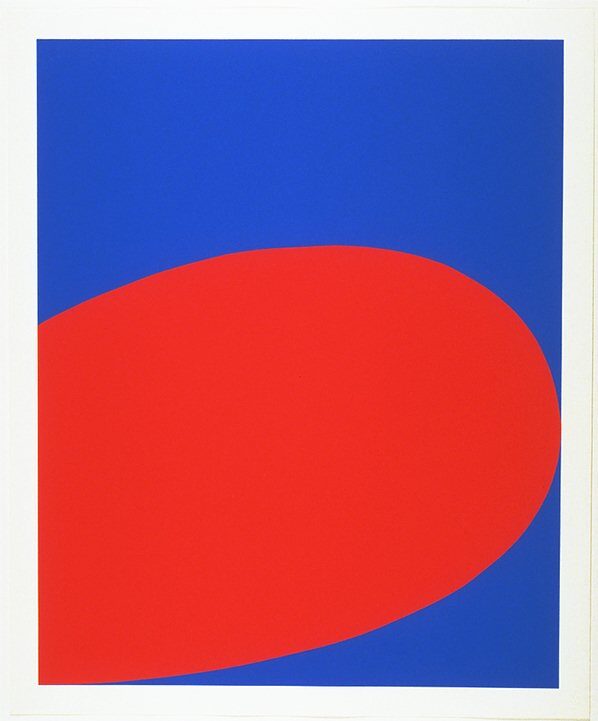Untitled, from “Ten Works + Ten Painters”
Ellsworth Kelly

Description
Sketching the landscape along the shore near his hometown of Hackensack, New Jersey, Ellsworth Kelly developed an early interest in natural forms that would become a recurring theme throughout his work. Kelly attended Pratt Institute in Brooklyn to study applied arts though a year and a half into his courses he was drafted into the army. Working as a camouflage artist, Kelly’s service took him to Europe with some time spent in and around Paris where he saw for the first time the work of the European Surrealists. He enrolled at the School of the Museum of Fine Arts in Boston after his discharge to study painting and art history on the G.I. Bill. While many artists of his generation were living and working in New York, Kelly moved to France and immersed himself in European life. In the summer of 1949, he was introduced to the Surrealist technique of automatic drawing, the process of rendering an image without looking at the paper but maintaining an unbroken visual connection between eye and object. It was a defining moment for Kelly, and art became for him a spontaneous act with often surprising results. In 1954 Kelly moved to New York and through friendships made in France with avant-garde artists John Cage and Merce Cunningham, he was introduced to artists of the second generation of the New York School.
Ellsworth Kelly’s signature style beginning in the 1960s was defined by large fields of color free from any trace of brushwork. In this untitled work we see an image adapted from the artist’s 1964 painting Red Blue. In the simple composition of sensuous, brilliant red sphere and vast, electric blue background the influence of natural forms in his work is apparent. The composition is one of subtle movement, the red sphere almost pushing out of the picture plane, its edge barely meeting the white of the paper and the push-pull of the complimentary colors almost vibrate with the intensity of their pairing.
Katie Weiss, Research Assistant, on the occasion of the exhibition The New York School: Abstract Expressionism and Beyond and Beyond, July 20, 2002 – January 19, 2003
---
Various Artists
Ten Works x Ten Painters
1964
Gift of Graham and Marianne Smith
George Ortman (born 1926)
Untitled
Screenprint on paper
1986/1.194.1
Frank Stella (born 1936)
Untitled
Screenprint on paper
1986/1.194.2
Ellsworth Kelly (born 1923)
Untitled
Screenprint on paper
1986/1.194.3
Robert Motherwell (1915–1991)
Untitled
Screenprint and collage on paper
1986/1.194.4
Andy Warhol (1928–1987)
Birmingham Race Riot
Screenprint on paper
1986/1.194.5
Stuart Davis (1894–1964)
Untitled
Screenprint on paper
1986/1.194.6
Roy Lichtenstein (1923–1997)
Sandwich and Soda
Screenprint on mylar
1986/1.194.7
Larry Poons (born 1937)
Untitled
Screenprint on paper
1986/1.194.8
Robert Indiana (born 1928)
External Hexagon
Screenprint on paper
1986/1.194.9
Ad Reinhardt (1913–1967)
Untitled
Screenprint on paper
1986/1.194.10
In the early 1960s there was a widespread printmaking revival in the United States. During this time numerous studios and workshops were established on the East and West Coasts, including Tamarind Workshop, Universal Limited Art Editions, Gemini G.E.L., and Crown Point Press. This revitalization of printmaking coincided with the rise of Pop art and Minimalism, two modern art movements that shared with printmaking an interest in modern technology, reproducibility, and mass production. Further support was generated by newly formed professional organizations and publications devoted solely to the medium and art of printmaking. Galleries and museums began to acquire, exhibit, and commission limited edition prints and print portfolios. One particularly popular strategy was to publish the work of several artists together. Ten Works x Ten Painters is one of the earliest examples of this type of portfolio and is especially notable because it was the first to be published by a museum. Samuel J. Wagstaff, the curator of paintings at the Wadsworth Atheneum in Hartford, Connecticut, who commissioned the portfolio, wanted to make work by major American artists accessible to a wider audience and range of collectors. Many of the ten prints express a Pop sensibility, either in subject or color choice, but the selection of artists was still diverse. Each of the prints was based on a painting the artists had previously created, and for Wagstaff, the unifying bond among the prints was their flatness and the ease in which the painting was translated to ink on paper.
All of the works in the portfolio—printed by Norman Ives and Sewell Sillman at Sirocco Screenprints in New Haven, Connecticut—were silkscreen prints on paper with the exception of two: the Lichtenstein, which was printed on mylar, and the Motherwell, which had additional paper collage elements. In both cases, it was the first time the artist had employed these techniques.
(6/28/10)
Subject Matter:
This work is one of ten prints published within a portfolio, “Ten Works + Ten Painters”, commissioned by Samuel J. Wagstaff from the Wadsworth Atheneum Museum in 1964. This portfolio was one of the earliest to have several artists published together to make major American artists accessible to a wider audience and range of collectors. Each print in this portfolio was based on a painting the artists had previously created. Some of the artists represented, in addition to Ellsworth Kelly, are Robert Motherwell, Frank Stella, Andy Warhol and Roy Lichtenstein, who were associated with the Pop and Minimalism art movements in the 1960s.
Physical Description:
A blue vertical rectangle contains a red oblong circle covering its lower section which is truncated at the lower left edge.
Usage Rights:
If you are interested in using an image for a publication, please visit https://umma.umich.edu/request-image/ for more information and to fill out the online Image Rights and Reproductions Request Form.